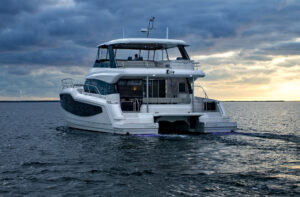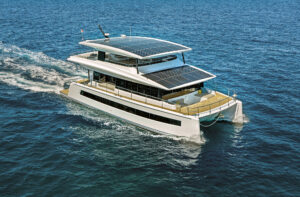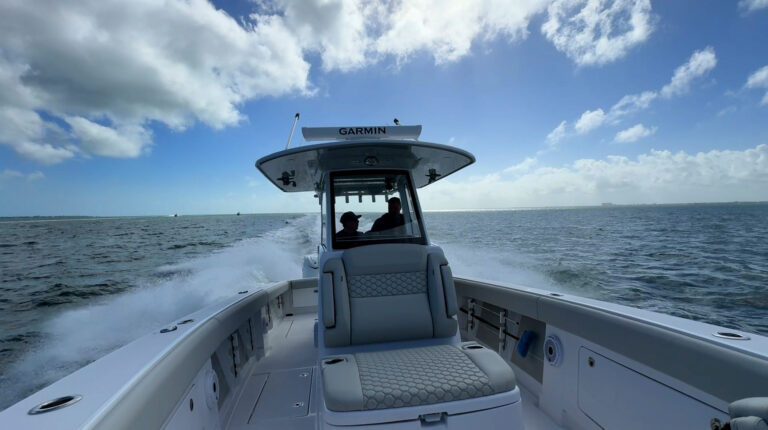Time for Lithium?
Lead-acid batteries are so 20th century; lithium’s the future. Making the switch is costly, but there are major benefits.
There’s been a lot of talk about lithium batteries in the past couple of years, and not all of it good: Lithium-ion batteries in e-cigarettes occasionally catch fire while in some unfortunate smoker’s pants pocket; airlines restrict the carriage of lithium-ion batteries for the same reason. And, in September 2019, a dive boat anchored off Santa Cruz Island in California caught fire, killing 34 sleeping passengers and crew trapped on board. One theory blames the fire on lithium batteries used in portable devices that ignited while charging. So, with all this bad press, why swap out the safe and reliable lead-acid batteries in your boat (whether flooded, AGM or sealed gel) for lithium?
The short answer is, lithium batteries perform better and last longer than many lead-acid batteries. They weigh less and take up less room. They can provide a higher percentage of nominal capacity than lead-acid batteries, without shortening their life. They maintain voltage through almost all the discharge cycle. They can be recharged much faster. And their only downside is initial cost, but that’s more than offset by their increased lifespan. The higher cost, by the way, may make skippers replacing lead-acid batteries stop and think, especially if they don’t plan on keeping their boats for enough years to enjoy lithium longevity. But for folks building or buying a new boat, the extra bucks are negligible, especially if they spend lots of time at anchor and are tired of listening to the genset hum.

But what about this catching fire thing? Frankly, it’s not an issue with the batteries we’re considering. Not all lithium batteries are alike, after all, and not all are “lithium-ion,” the term commonly used to describe all lithiums, whether inserted in a tablet or camera, or mounted in an engine room. The difference is in the electrolyte. Lithium-ion batteries, which are used to power phones, tablets and other portable electronics, use lithium-cobalt-oxide (LiCoO), which provides lots of energy versus size and weight. You probably have one of these batteries in your pocket right now. Only thing is, cobalt is unstable, so if charged improperly, this type of lithium-ion battery can get hot and catch fire—not the kind of thing you want on board.
Lithium-iron batteries, on the other hand, use a lithium-iron-phosphate (LiFePO) electrolyte that’s more stable, not combustible and can better resist mishandling during charging and discharging. It’s a trifle less energy dense than its cobalt-based cousin, but it’s also less expensive. Lithium-iron batteries can last for thousands of discharge/charge cycles—three, four, maybe five times as many as lead-acid batteries. (The exact numbers depend on who you ask; some battery manufacturers claim as many as 5,000 cycles for their lithium batteries.) The batteries discussed here are lithium iron phosphate, and they’re fine for installing aboard boats.
Cost Versus Value
Let’s get this out of the way up front: A lithium battery can cost three or four times as much as a lead-acid AGM battery of similar nominal capacity. For example, I found a 110 Ah Group 31 AGM battery at West Marine listed for $272; a Northstar High Performance AGM, also Group 31 but with 102 Ah, costs $440. A 100 Ah Group 31 lithium battery from Smart Battery in Clearwater, Florida, a drop-in replacement for lead-acid Group 31s, with a built-in battery management system, or BMS, costs $1,250 on the company website. (A battery management system protects against high or low voltage, short circuits and reverse polarity, and it balances the charge state of the internal cells and disconnects the battery if anything goes wrong. A BMS is necessary for all lithiums; sometimes it’s a separate component.) Of course, $1,250 is a bit of a slap in the wallet, but Smart Battery claims their lithium batteries last from 3,000 to 5,000 recharge cycles, many times more than the typical lifespan of a lead-acid battery.
The actual lifespan of a battery in recharge cycles—full discharge followed by full recharge—depends primarily on how deeply it’s discharged before recharging. Deep-cycle lead-acid batteries can be discharged to 80 percent capacity, but they’ll last twice as long if taken down to only 50 percent, the depth of discharge (DOD) recommended by most experts. Recommended DOD is typically 80 percent, day-in and day-out, and some manufacturers, including Smart Battery, claim 100 percent is okay. Bottom line, no matter which kind of batteries you have, don’t discharge them too deeply, and recharge promptly afterwards, for the best service life. (Note that the recharging system for lead-acid batteries may not work with lithiums, especially on boats with older electrics. Check with your marine electrician before buying lithium batteries.)
Lithium batteries aren’t for every onboard application. They’re not as valuable for starting batteries, but come into their own for deep-cycle house usage, and maybe as dual-purpose batteries in boats with simpler electrical needs. Starting a properly functioning engine takes maybe 5 percent of battery capacity, and it gets recharged right away, so a lead-acid starting battery will last for thousands of cycles, and maybe years of service. Why pay the premium for starting batteries? Buy a good-quality AGM starting battery and use the money you save to buy more fuel.
Starting from Scratch
The benefits of lithium batteries aren’t lost on boatbuilders, and installing lithiums versus lead-acid batteries in a new boat is free (well, almost free) compared to the cost of the boat. Working in conjunction with engineers from Power Products LLC, Sea Ray has developed a high-capacity lithium battery system. It’s called the Fathom-e Power System, and the first one is installed onboard the new SLX-R 400e. The Fathom-e system also provides a convenient blueprint for boat owners who might want to invest in lithium-based house batteries for their own vessels.
Dave Maryanov, marketing manager for Power Products, said that the heart of the Fathom-e Power System is a single bank of four, 400 Ah Mastervolt batteries with integral BMS and battery monitoring, recharged from shore power by two 3000-watt CombiMaster inverter/chargers that will charge the batteries from depleted to topped-off in about 4½ hours. The batteries replace the genset, so there’s no fuel burn needed to make electricity, no maintenance, no exhaust fumes, no annoying genset hum. At 1600 Ah and 80 percent DOD, there’s 1280 amps on tap from the fully charged batteries. Maryanov said the lithiums should be good for 3500 recharge cycles. He added that the Fathom-e system requires no special user input—it’s as easy to use as a hybrid car.
The batteries and CombiMasters are connected to an EasyView 5 monitor that displays voltage, state of charge, loads on the system and other vitals. You need a battery monitor, not just a voltmeter, to oversee a lithium battery. A lead-acid battery provides about 25 percent of its capacity at full performance, but then it starts to deplete—you’ll see a gradual loss of voltage until the battery’s dead, so the voltage reading at any point indicates the state of charge. Voltage readings don’t help much with a lithium battery, which will put out full voltage until it’s about 80 percent depleted; then the voltage drops precipitously. That’s why the battery meter in your cell phone shows a full charge for a long time, you lose a bar, and then the phone goes dead in an hour. A battery monitor tracks power use more accurately; installing one is a good investment even for lead-acid battery systems.
The Sea Ray SLX-R 400e carries triple Mercury Racing 450R outboards, each with a 115-amp alternator, so the boat’s batteries will recharge quickly once the engines are running. The alternators are each wired to an AGM lead-acid starting battery; the starting batteries are connected to the lithium bank through three Charge Mate Pro 90 DC-to-DC converters. The Charge Mates ensure the starting batteries are recharged first, then the current is fed to the lithiums; they also regulate the flow of amps to offset the surges of power that are common from alternators, Maryanov says. This makes recharging more efficient. When the engines are shut down, the Charge Mates isolate the starting batteries from the lithiums to prevent inadvertent discharge. At the dock, a separate ChargeMaster charger keeps the starting batteries topped up.
Maryanov explains that it’s important to match the recharging capacity to the batteries when designing a lithium system, or you lose the advantage of fast recharging. Although some experts suggest limiting recharge amps to maximize the lifespan of a lithium battery, he says it’s fine to pump in amps equal to the battery’s capacity, e.g., recharge a 100 Ah battery at 100 amps. Don’t worry about the 50 percent limit, he adds. Doing this often means upgrading the inverter/charger and maybe the alternator, too. You also have to match the recharge voltage to the battery; newer chargers have a switch on the back, or dip switches inside, to set them for lithiums. Installing a lithium battery system is a job for pros, so let them figure out the voltage settings.
Time for Lithium? I think we’ll be seeing systems like Sea Ray’s on a lot more boats before too long, especially cruising boats for folks who like to anchor out but don’t want to deal with a genset. Ah yes, lithium—the battery of the future, available today.

Advice from Front Street
The professionals at Front Street Shipyard in Belfast, Maine, have installed many lithium battery systems. I spoke with the yard’s president, J.B. Turner, and systems manager, Ben Feeney, about what to consider when thinking of making the switch.
Both said that since lithium batteries can be discharged further, you can either go with smaller, lower-capacity batteries and get the same effective output, or use lithiums with the same nominal capacity as the lead-acids they’re replacing but get more usable power.
As for the battery management system, they explained that a built-in BMS is less complex, but if there are multiple recharging sources, it’s better to install a remote BMS. And you also need a battery monitor, which means installing a shunt for each D.C. power source; the shunt feeds power usage info to the monitor. While some BMS put out charging info, at Front Street they prefer using a shunt.
All the existing charging systems have to be reviewed. Older chargers won’t have a lithium setting and should be replaced. Charge controllers have the same issue; they have to have a lithium battery setting or there will be problems. In some installations, Turner and Feeney recommend a higher output alternator too, or a regulator setup for lithium charging. Replacing just the regulator obviates mounting issues. The genset can usually be left alone—it’s feeding the charger which is feeding the lithiums—as long as the charger isn’t dramatically changed in output.
Finally, you don’t always have to change all the batteries. Sometimes the manufacturer of an appliance—a bow thruster, for example—will recommend a traditional lead-acid battery. “Each manufacturer has different requirements,” Turner and Feeney told me, “so it is important to check.”










